
Ellsworth Price Bertholf was a Congressional Gold Medal recipient who later served as the fourth Captain-Commandant of the United States Revenue Cutter Service and because of the change in the name of the agency in 1915, the fourth Commandant of the United States Coast Guard. His leadership during his tenure as Commandant was critical to the U.S. Coast Guard's survival at a time when outside agencies wanted to either take it over or split its missions up among several agencies.

USS Wilderness was a wooden-hulled, side-wheel steamship in the United States Navy during the American Civil War. After the war, she served as a revenue cutter. In 1873, she was renamed John A. Dix for former Secretary of the Treasury John Adams Dix.

USRC Windom was a revenue cutter of the United States Revenue Cutter Service and United States Coast Guard that served from 1896 to 1930. She was named for William Windom, the 33rd and 39th United States Secretary of the Treasury. She served during the Spanish–American War with the United States Navy. Windom was recommissioned as USCGC Comanche in 1915 and again served with the Navy as USS Comanche during World War I.

USS Bancroft was a United States Navy steel gunboat in commission from 1893 to 1898 and again from 1902 to 1905. She saw service during the Spanish–American War. After her U.S. Navy career, she was in commission in the United States Revenue Cutter Service from 1907 to 1915 as the revenue cutter USRC Itasca, and in the Revenue Cutter Service's successor service, the United States Coast Guard, as the cutter USCGC Itasca from 1915 to 1922. During her Coast Guard career, she saw service during World War I.

USS Wilmington (PG-8) was the lead ship in a class of two United States Navy gunboats. She was laid down on 8 October 1894 at Newport News, Virginia, by the Newport News Shipbuilding Company; launched on 19 October 1895; sponsored by Mrs. Anne B. Gray; and commissioned on 13 May 1897.
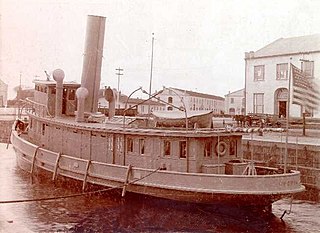
USRC Hudson, known for her service during the Battle of Cárdenas, was the United States Revenue Cutter Service's first vessel to have a steel hull and triple-expansion steam engine.
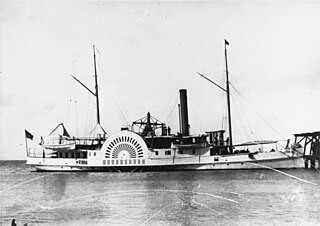
USS Delaware was a steamer acquired by the Union Navy for use during the American Civil War. She had a very active naval career as a gunboat for over three years, and after the war served as a revenue cutter for over 37 years. The steamer was sold to the private sector in 1903, and disappeared from shipping registers in 1919.
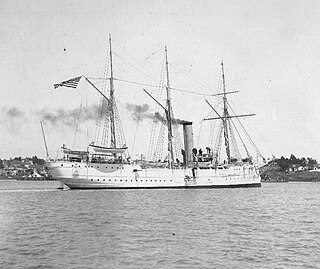
USS McCulloch, previously USRC McCulloch and USCGC McCulloch, was a ship that served as a United States Revenue Cutter Service cutter from 1897 to 1915, as a United States Coast Guard Cutter from 1915 to 1917, and as a United States Navy patrol vessel in 1917. She saw combat during the Spanish–American War during the Battle of Manila Bay and patrolled off the United States West Coast during World War I. In peacetime, she saw extensive service in the waters off the U.S. West Coast. She sank in 1917 after colliding with another steamer.
USRC Walter Forward was a schooner constructed for service with the United States Revenue-Marine. She was more commonly known as USRC Forward. Forward served with the United States Army and United States Navy in Mexican waters during the Mexican–American War and was commended for her actions during the Tabasco River landings by Commodore Matthew C. Perry, U.S. Navy. After the war, she was transferred to the United States Coast Survey for a short time as USCS Walter Forward before being returned to the Revenue-Marine for service during the 1850s and the American Civil War.

USCGC Tallapoosa (WPG-52) was a United States Coast Guard cutter of the Tallapoosa-class and was designed to replace the revenue cutter Winona. Her hull was reinforced for light icebreaking. She was initially stationed at Mobile, Alabama, with cruising grounds to Lake Pontchartrain, Louisiana, and Fowey Rocks, Florida. During World War I she escorted convoys out of Halifax, Nova Scotia. After the war she served with the Bering Sea Patrol before returning to Savannah, Georgia, before World War II. During the war Tallapoosa assisted with convoy escort duty and anti-submarine patrols.

USRC Manning was a revenue cutter of the United States Revenue Cutter Service that served from 1898 to 1930, and saw service in the U.S. Navy in the Spanish–American War and World War I.

USRC Onondaga was an Algonquin-class cutter built for the U.S. Revenue Cutter Service for service on the Great Lakes. Because of the Spanish–American War, she was cut in half shortly before completion and transported to Ogdensburg, New York for service on the Atlantic coast although the war ended before she could be put into service. After the formation of the United States Coast Guard in 1915 she became USCGC Onondaga. She served as a patrol vessel at various Atlantic coast ports before World War I and unlike most Coast Guard cutters during World War I, she remained under the control of the Commandant of the Coast Guard. After the war she patrolled for a brief time based at New London, Connecticut before being decommissioned in 1923.
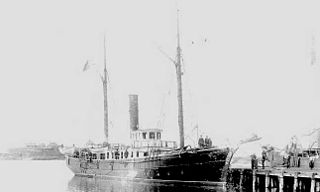
USRC Dexter was a Dexter-class cutter of the United States Revenue Cutter Service in commission from 1874 to 1908. She was the second ship of the Revenue Cutter Service to bear the name. The other Dexter-class cutters, all commissioned in 1874, were Dallas and Rush. Dexter was built by the Atlantic Works Company at Boston, Massachusetts. Captain John A. Henriques accepted her for service on 6 June 1874, and she was commissioned into the Revenue Cutter Service on 18 June 1874. Her role in the rescue of passengers from the sinking SS City of Columbus under winter gale winds brought her nationwide popular acclaim.
USRC Forward was a revenue cutter constructed for the U.S. Revenue Cutter Service in 1882 by Pusey & Jones shipyard in Wilmington, Delaware. She was the second Revenue Cutter Service vessel named Forward and was named for Walter Forward, the fifteenth United States Secretary of the Treasury. The iron-hulled vessel originally cost US$72,750 and was powered by a two-cylinder steam engine with a topsail schooner brigantine sail pattern. Although Forward was considered a model ship at the time of its construction, it was severely underpowered and had unreliable machinery. The cost of repairs in the first fifteen years of operation was US$52,000.
USRC Kewanee was a Pawtuxet-class screw steam revenue cutter built for the United States Revenue Marine during the American Civil War.

USCGC Unalga (WPG-53) was a Miami-class cutter that served in the United States Revenue Cutter Service and later the U.S. Coast Guard and U.S. Navy. The early part of her career was spent patrolling the Pacific coast of the United States and the Bering Sea. After 1931 she did patrol work off Florida and in the Caribbean. After Unalga was sold in 1946, she was renamed after Jewish Agency leader Haim Arlosoroff and used for six months for moving Jewish refugees from Europe to Palestine before being forced to run aground by British Navy ships near Haifa.

The United States Revenue Cutter Morrill was built at Wilmington, Delaware, and commissioned in October 1889 under the official name Lot M. Morrill. She served off Florida and in the Spanish–American War. She then served on the Great Lakes. After the United States entered into World War I in 1917, she came under the operational control of the United States Navy. She rendered particular assistance in the aftermath of the December 1917 Halifax Explosion. Following the war Morrill again served on the Great Lakes. She was decommissioned in October 1928.
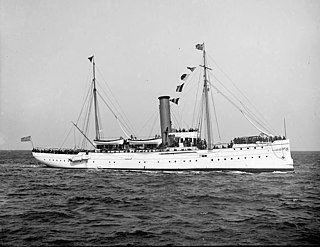
USRC Gresham was a cruising cutter and auxiliary gunboat built for the United States Revenue Cutter Service to patrol the Great Lakes. She was one of a series of cutters named for former U.S. Secretaries of the Treasury. Her namesake Walter Q. Gresham served as the 35th Secretary of the Treasury in 1884 and died in 1895 while serving as the 33rd U.S. Secretary of State. She became part of the newly created United States Coast Guard in 1915, and also served as a coastal convoy escort and patrol boat under United States Navy control during both World War I and World War II. After being decommissioned by the Coast Guard in 1944, she eventually came under Israeli control in 1947. She carried Jewish refugees from Italy to Palestine and later served in the fledgling Israeli Navy until 1951.
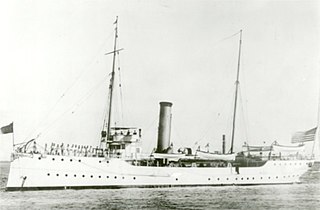
USRC Algonquin was an Algonquin-class cutter built for the U.S. Revenue Cutter Service for service on the Great Lakes. Because of the Spanish–American War, she was cut in half shortly before completion and transported to Ogdensburg, New York for service on the Atlantic coast although the war ended before she could be put into service. She was homeported at San Juan, Puerto Rico from 1905 to 1917. Algonquin served briefly for the U.S. Navy along the Atlantic Coast in the summer of 1898 before being returned to the Treasury Department. After the formation of the United States Coast Guard in 1915 the vessel became USCGC Algonquin. The ship served as a patrol vessel at Norfolk, Virginia at the beginning of World War I before being assigned convoy duty in the Mediterranean. In February 1919 Algonquin was transferred to the West Coast and served in the Pacific Northwest and Alaska until being decommissioned at San Francisco in December 1930.















